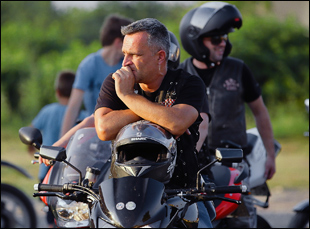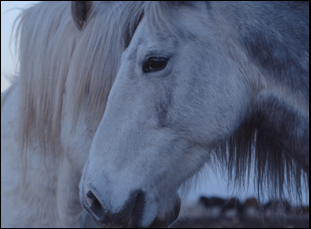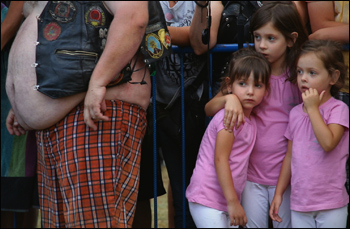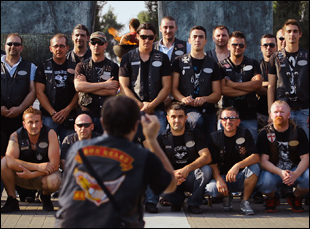When Shawn Convey returned to the Music Box Theater in Chicago this week for the weeklong run of his debut feature “Among Wolves,” it marked something of a full-circle moment for the filmmaker, having once sold most of his belongings there nearly 14 years earlier on a hunch he might find a story in the Balkans. A still photographer by trade at the time, Convey had been wandering around Croatia, Serbia and Bosnia and Herozgovina after a personal trip abroad led him to rethink things professionally, and now back in the Windy City with his feature debut, he was wondering what audiences might think.
“We’re playing a 700-seat room six of the seven screenings,” Convey said earlier this week. “I’m really curious how it plays to a larger general audience and not a specified film festival audience,” alluding to the two years he’s already spent on the road with the film.
In all likelihood, the audience’s curiosity will be rewarded as his own was, ultimately finding a compelling tale in Livno, a city in the middle of the former Yugoslavia still reeling from the Bosnian War of the 1990s. While much of the town remains unemployed and young people have fled seeing no future there now that the factories have been long shuttered, a strong sense of community has been forged by those who have stayed, particularly the Wolves Moto Club, a Harley Davidson-riding collective of war vets who may roar down the dirt roads of the city, but quietly go about keeping the city running, tending to wild horses in the region, fixing dilapidated houses and helping out with blood drives. Just as there’s great sensitivity to their activities hiding under a muscular facade, Convey’s strong observational eye gives way to a nuanced portrayal of how these vets cope with their ongoing trauma and continue to serve the people, primarily revolving around the Wolves’ leaders Branko “Lijo” Lijovic and Zeljko Kristo.
With the film’s Chicago run leading to its release on video-on-demand, Convey reflected on the project that he’s devoted such a large part of his life to and the patience required to witness change happening before his camera, as well as how he initially used his inability to speak the native language as an asset and why observational filmmaking gets more difficult over time rather than easier in terms of communicating a story to an audience.

That’s funny. Indirectly, there’s a wedding – my brother got married in Italy and that got me to the former Yugoslavia [where] I just bummed around for a couple weeks. Being there, I just left with a million questions and it coincided with this point in my life where I felt I could leave [my routine] and explore and see the world a little bit more. Also, I had made up my mind years ago, but hadn’t figured out how to transition from still photography to film and when I was there, I thought “This is how I do it. I have to come here and find a story that depicts a realistic version of hope and healing after extreme communal trauma as opposed to just focusing on the war, the guns and the politics, [instead] focusing on the people who are left behind to pick up the pieces.”
How’d you locate this specific motorcycle club in Livno?
That took quite a while. There were a bunch of false starts with other subjects that all had value, but for whatever reason, I wasn’t feeling right about or they weren’t, so I had like a Google Alert set and every morning I had my coffee and I would read stories from around Bosnia-Herzogovina. I read this little blurb about these middle-aged guys trying to protect wild horses and I’m like, “That’s not normal” [because] I had lived there for almost two years at this point and I was in an area that’s got 70% unemployment rates and still dealing with human rights issues and [other] basic things. Most people don’t have enough time to worry about animals, especially middle-aged men. [laughs] So I rented a car, drove down [to Livno] and 45 minutes later, I’m up in the mountains with these two guys I don’t know in a Range Rover, looking at all these beautiful wild horses.
While I was out there, I started realizing there’s a little bit more depth than even I first had guessed. I found out they were veterans and they had this motorcycle club and I assumed that this is some sort of alternative therapy for them, so I kept coming back and they kept welcoming me back and after about two years of that trust dance, I went there for eight months and just filmed.

Yeah, it did. Honestly, I think I had wrapped my brain around it more conceptually than I did with the actual film [because] we did a two-week experiment in 2012 and that footage definitely represented in the film. In fact, the film ends with some of that footage, so we were thankful to get that, but because it’s observational, they have to tell the story, so it doesn’t matter what you know. You have to catch them doing it and thinking about it and saying it to each other. So we had 425 hours worth of footage that we shot and then Kevin Ripp, our writer and our executive producer, had the insane task of finding the dialogue that we had to have translated [to tell the story]. I’d be like, “Kevin, we need to represent this thought,” “Kevin, we need to show them doing this…” and he’d [have to] dig through volumes of paper to help us shape the story. [laughs]
All three of us, [including] our editor Katharina Fiedler, knew we wanted to leave you with humanity, so as opposed to building the normal [dramatic] bell curve that you get a grand climax and then having some resolution, that felt unnatural to life [since you usually] start with your guard up and with stereotypes and misconceptions and then once you’re in the room long enough and you get a feel for what’s happening, you start to understand the humanity you’re dealing with. To me, that’s what a real human relationship is.
While you don’t dwell on the war, it obviously has such a dramatic influence on the lives of your characters and it’s handled beautifully but sparsely – was it tricky to figure out how to express that?
Yeah, it was. I made a decision early on in the process that I didn’t want this to be a war film. However, to not have war be in there is completely disingenuous to the area, so we went in with this concept to let the war happen as they shed light on it [because] when you’re in an area that has been riddled by war the way that they have and they’ve been suffering the consequences for 20 years now, war just becomes as much of your daily life as anything [else]. So we wanted to find the power in the constant reminders of the war rather than tackling war head-on.
One thing that I did really want to make clear, which is not clear in the film, is that [the Wolves] are a multi-ethnic motorcycle club and in the United States, that’s like, “So what?” [laughs] But there, it’s a big deal and they downplay it so much that they don’t talk about it [because] for them, this is the way life should be. And I agree with that. However, in the area that they’re living in, that’s not normal. There’s still ethnic tension, so [that diversity within the Wolves] is pretty fantastic and one of my biggest regrets, [though] we tried hard, [is that] I was not able to figure out how to organically be true to the observational nature [of the rest of the film].

Yeah, I think my still photography background and just the way that I view the world played a large role in that. I’m always looking for the smaller metaphors to try and build the larger metaphor and I see the world in a very visual way, so I puzzle together the truth visually. Going over [to Bosnia], I had this understanding of truth, but I was constantly was always looking for these little vignettes that I hope would translate to the viewer something closer to the reality than anything that anything a direct talking head interview would ever say. And moments like the one you’re mentioning have to be witnessed, and it was my extreme honor to be witnessing all these things that I had seen while I was over there and to try and communicate those special moments to you. There’s this whole idea when you’re editing a film of “kill your darlings” and I don’t know that’s true with observational films because your darlings are your truths, and the more that you can figure out how to fit in those truths, the more honest and real the film is.
I also never learned the language. Living in Mostar in Sarajevo, many people spoke English and it was very easy to get by with very, very rudimentary knowledge of a couple hundred words. But in Livno, nobody else spoke English, so I understood the story that I wanted to tell visually, but we had a good friend of mine helping me with running sound and also translations and communications and setting up interviews. In some ways, that was very limiting because I never knew in detail what was happening around me, but in reality when you have that information taken away from you – that noise of dialogue, [which] can be confusing when you get wrapped up in what’s being said as opposed to what’s actually happening – it allowed me to actually focus and always concentrate on the broad strokes, keeping that red string, as they say, where I never strayed.

Not really, but what we did find when we got back was if we view it chronologically, earlier on, everything that was being done around me was contextualized by the characters because I was new to them. But as the filming went on and they got used to me, nothing was contextualized. That’s one of the unique challenges of observational documentary is that everything has to have enough context where the viewer isn’t completely lost. [laughs] Just because I know we’re going to go over here and what “we’re going to see that guy” means, the viewer would never know what “there” is or who that guy is, so there were a lot of these stories and thoughts, just basically getting into Lija’s brain, that he holds dear that I did not have a clean, contextual audio source for. So I came up with this idea of reaching out to a young female journalist from the Czech Republic that a friend of a friend of mine had put me in touch with and she she did interviews with a sound guy friend of mine who lived in Sarajevo. Probably half of the off-screen monologues that you’ll hear [came from that] and [the subjects] didn’t say anything new, but because they were telling it new to a person for the first time, everything was contextualized.
I wondered whether that voiceover came from a master interview or it was more surreptitious during filming.
It was a little bit of both. We were interviewing them all throughout because I knew I didn’t want them talking directly to screen. It’s definitely not anything that I hadn’t done before, but I’ve seen the film like a thousand times now and whenever I watch it, it strikes me that it is interesting because you’re always aware that they’re talking to someone, but that someone is never me because you never hear the voice. It’s a weird in between where they’re always speaking to the audience in a way, almost like the audience is in the Range Rover with them and they’re explaining what is happening.
What’s it been like showing the film to audiences?
It’s been a complete joy. It’s a tough sell, this film. Even explaining the film to people has has ups and downs. It’s like [you say], “It’s got wild horses and motorcycles,” and people are like, “Yeah!” [laughs] Then you’re you’re in Bosnia and it’s observational and then they’re like “Ohhh…” [laughs] So we’ve had a lot of rejection and also a lot of acceptance as far as the festival circuit goes and once people see it, the reception has been really, really heartwarming. people really respond to the characters and I feel like the compassion and the empathy we hoped would be there is almost always there and I’ll get dozens and dozens of people come up to me after and just want to keep talking about the film. It’s not uncommon for a Q & A to go almost an hour long. So it’s really been fantastic.
“Among Wolves” is currently playing at the Music Box Theater in Chicago. It is also now available on VOD and DVD.




